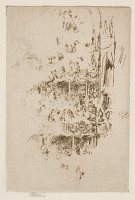The Abbey Jubilee | ||
| Number: | 296 | |
| Date: | 1887 | |
| Medium: | etching and drypoint | |
| Size: | 99 x 67 mm | |
| Signed: | butterfly at right | |
| Inscribed: | no | |
| Set/Publication: | no | |
| No. of States: | 2 | |
| Known impressions: | 3 | |
| Catalogues: | K.316; M.326 | |
| Impressions taken from this plate (3) | ||
KEYWORD
abbey, arch, architecture, building, jubilee, people.
TITLE
Whistler clearly had trouble with the spelling; variations in the title are as follows:
'The Abby Jubillee' (sic) (1887/1888, Whistler). 6
'Abbey Jubillee' (1889, Whistler). 7
'The Abbey – Jubilee Day' (1898, Wunderlich's). 8
'Abbey Jubilee' (1902, Edward Guthrie Kennedy (1849-1932)). 9
By correcting Whistler's spelling, his original title becomes 'The Abbey Jubilee', which is the preferred title.
'The Abby Jubillee' (sic) (1887/1888, Whistler). 6
'Abbey Jubillee' (1889, Whistler). 7
'The Abbey – Jubilee Day' (1898, Wunderlich's). 8
'Abbey Jubilee' (1902, Edward Guthrie Kennedy (1849-1932)). 9
By correcting Whistler's spelling, his original title becomes 'The Abbey Jubilee', which is the preferred title.
6: List, [1887/1888], GUW #13233.
7: List, 18 July 1889, GUW #13235.
8: New York 1898 (cat. no. 229).
9: Kennedy 1902[more] (cat. no. 288).
DESCRIPTION
This shows the tiers of temporary spectators' galleries erected in Westminster Abbey. They are crowded with people, and decorated with swathes of material. In the upper seats, groups of people sit gazing down. To the right is a row of tall pointed arches supported on pillars, with a hint of smaller arched windows above.
SITE
A view looking across the nave and down one side of Westminster Abbey, London. The etching was probably drawn early, as spectators assembled, and before the actual ceremony, as described by the Times: 'The great ones of her enormous realm were there, and many besides. The eye wandered over groups of statesmen, writers, orators, famous soldiers and sailors, ermine-clad judges, divines in rarely worn vestments, Asiatic princes gleaming with jewels, forms and faces as fair as they were Royal and noble, a bench crowded with Kings and heirs of Kings.' 10
10: 'The Thanksgiving Service in Westminster Abbey', The Times, London, 22 June 1887, p. 9.
DISCUSSION
One of Whistler's smallest etchings, this is a curious record of a large-scale formal and religious celebration of the reign of Queen Victoria: it is like looking through the wrong end of a telescope. The Times thought that the Jubilee illuminations would not appeal to Whistler:
'An almost magic effect ... is produced by the steeple of St Magnus, lit up by the electric light of some building opposite and rising into mid-air with startling brilliancy. Here is a subject for a painter of night scenes. Turner would have positively delighted in it. For Mr Whistler the outline would be too graphically defined. He would prefer the silvery dimness of the river with the reflex of the lights from the bridges.' 11
